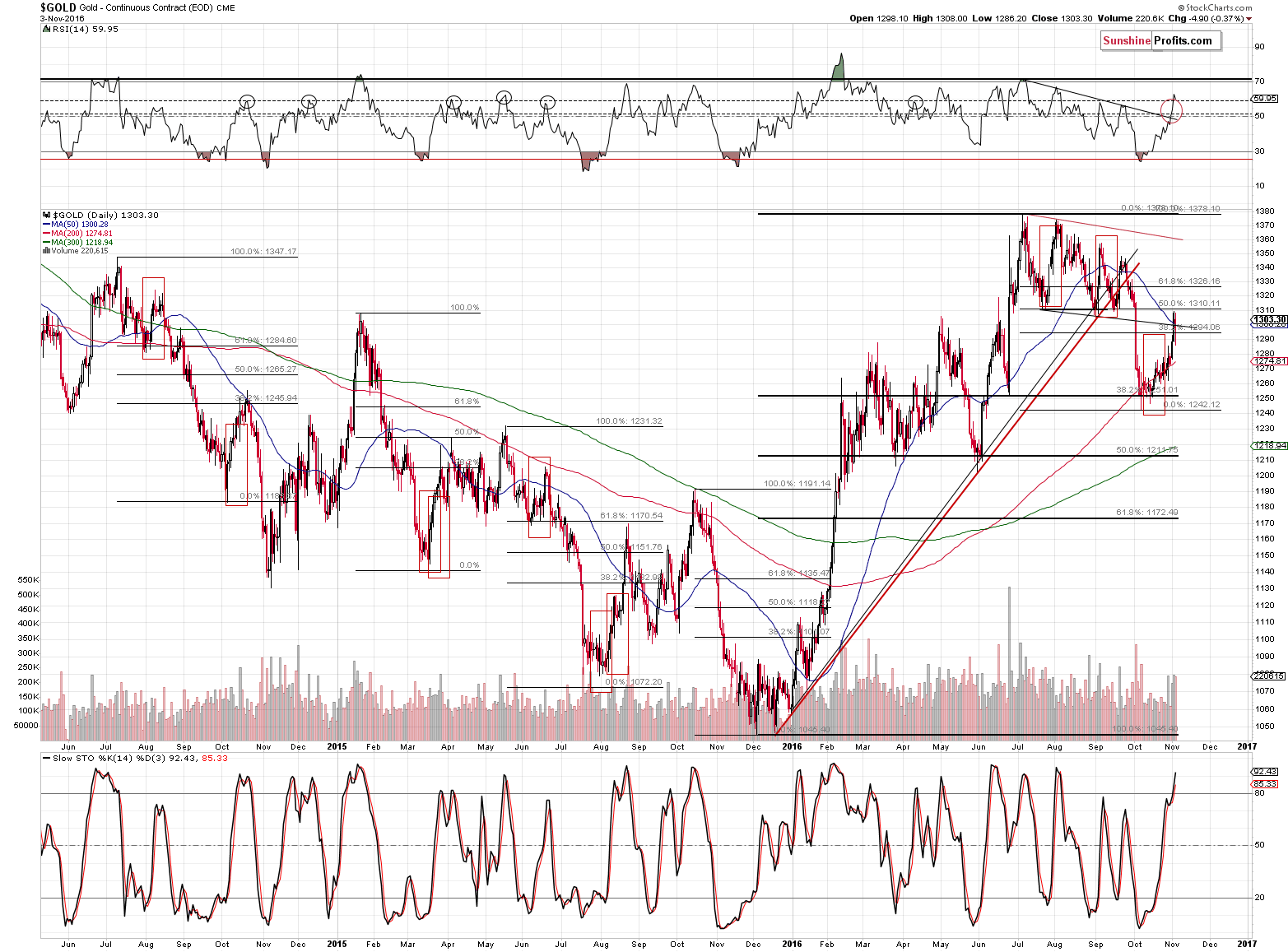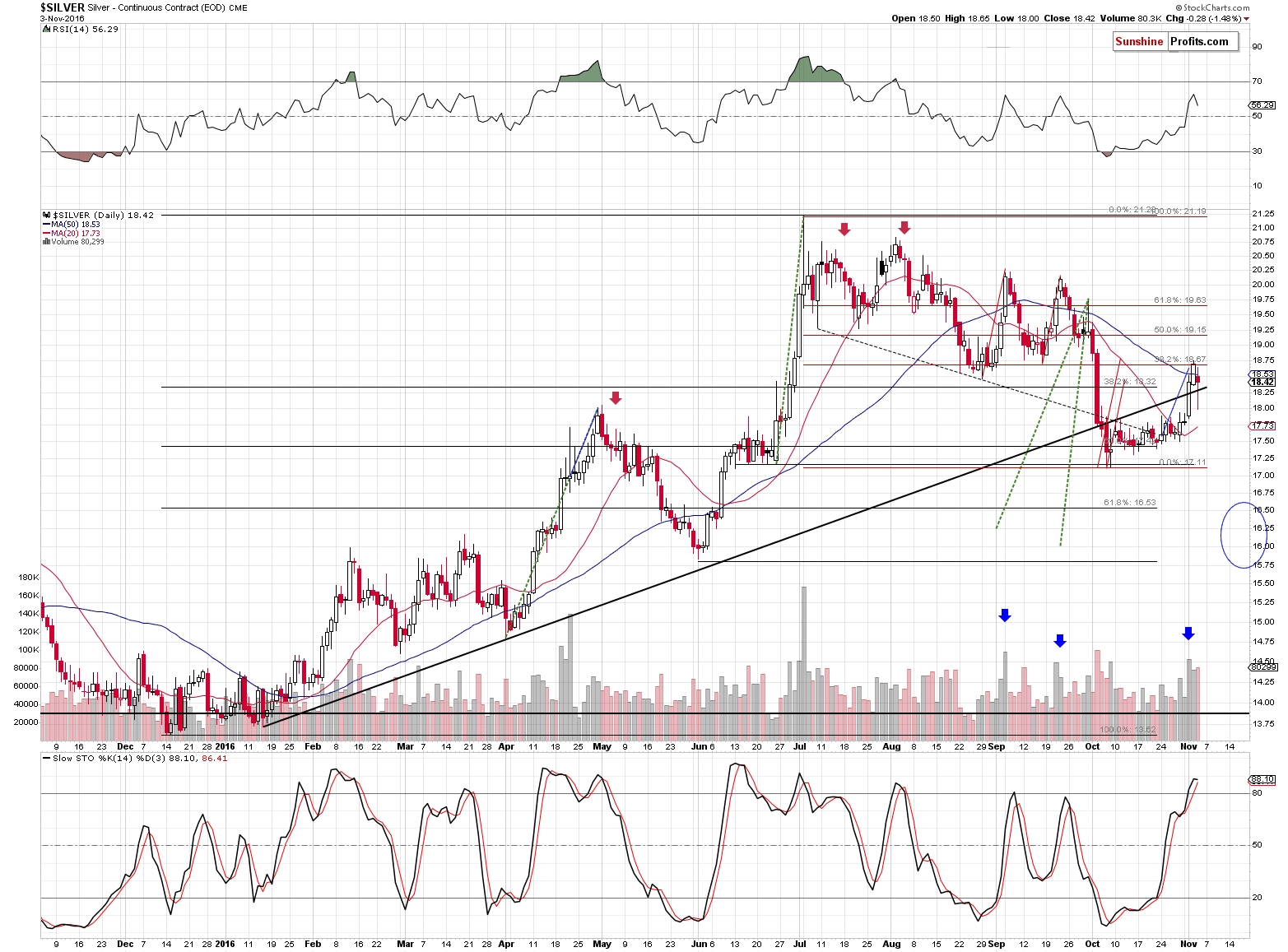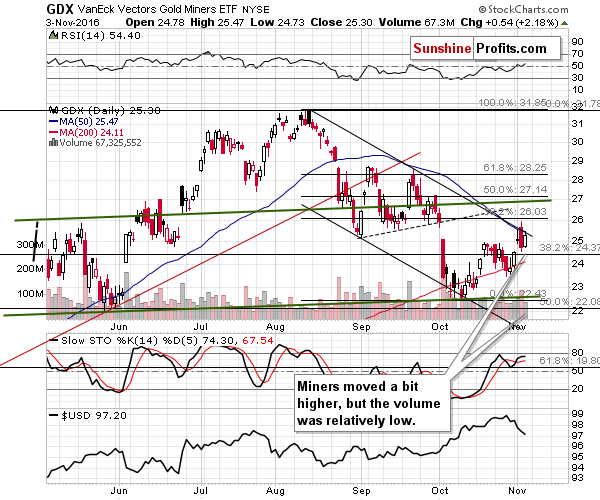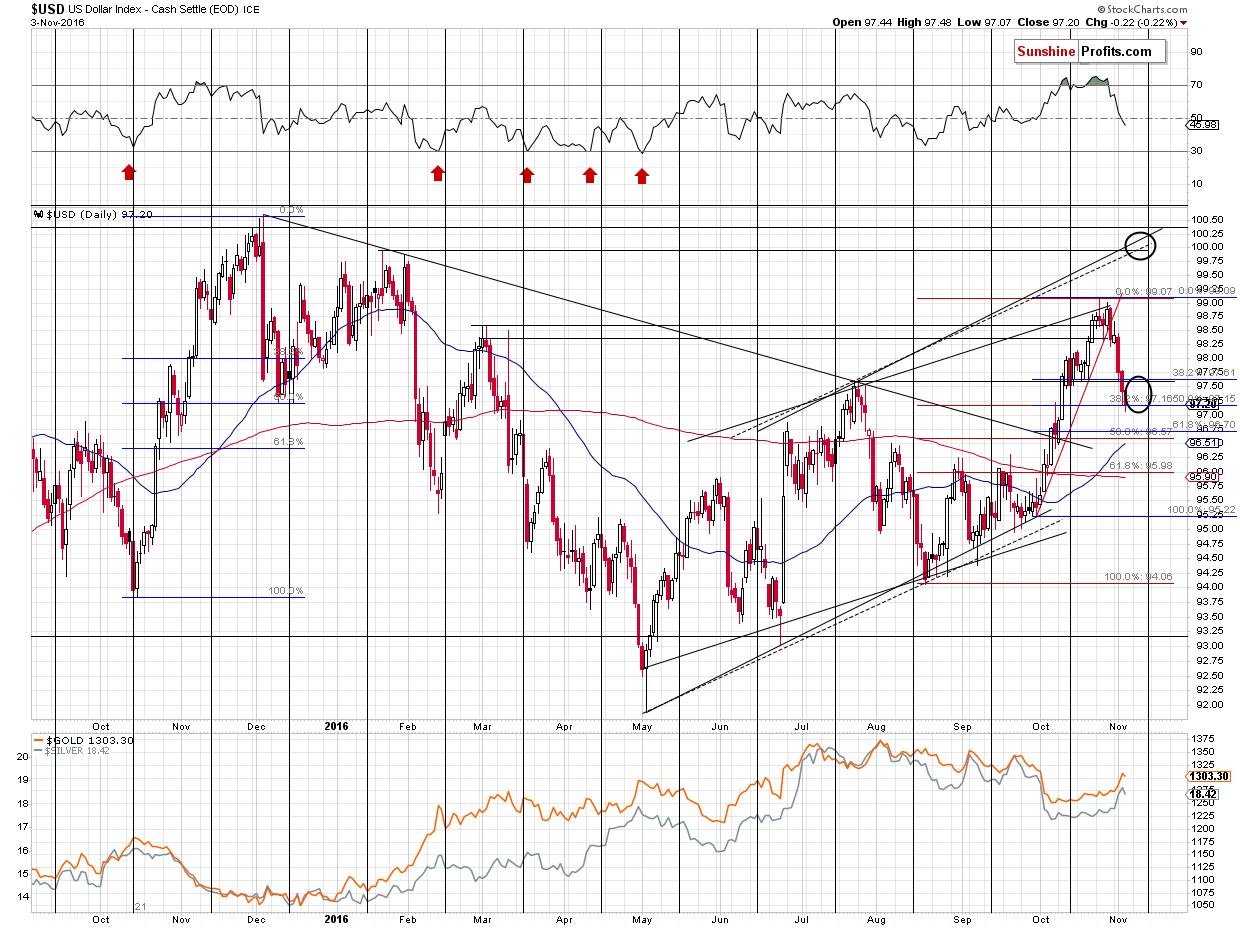Briefly: In our opinion, (full) speculative short positions in gold, silver and mining stocks are justified from the risk/reward perspective.
Yesterday, we saw the exact opposite of what we saw previously – gold declined, while mining stocks rallied – what can we infer from that?
In short, it’s not as important as it may appear based on the size of the phenomenon, but we’ll discuss that a bit later. For now, let’s take a look at the charts (charts courtesy of http://stockcharts.com).

In yesterday’s alert, we wrote the following:
Gold rallied yesterday, moving close to several important resistance levels. Gold was only about $1 away from the 38.2% Fibonacci retracement level and at the moment of writing these words, gold is trading at $1,295 and the intra-day high (so far) is $1,298 – very close to the $1,300 resistance. The latter is based on the July and September lows and the declining line based on them. The 50-day moving average is also just $2 above $1,300, so it’s making the $1,300 level even more likely to stop the rally.
Gold moved above the $1,300 level, but only temporarily – it finally closed below $1,297 (based on kitco.com’s closing prices – the prices provided by stockcharts.com might not be as reliable at this time) and at the moment of writing these words, gold is trading at about $1,294 – clearly well below $1,300.
The brief breakout above the mentioned resistance levels was therefore invalidated and the implications are bearish.
Gold moved back and forth yesterday and its nothing uncommon to see this kind of behavior when gold’s topping. The July 2016 top (which was most likely THE 2016 top), the August top and the late September top were all formed in this way – gold moved back and forth only to slide shortly thereafter.
The support and resistance levels were not decisively broken, so there are no significant bullish implications of this week’s upswings.
The RSI indicator is at about 60, a little above our target area, but that’s nothing unusual as well – for instance the May 2015 top formed in this way as well. The Stochastic indicator is above 90, which indicated that a top is just around the corner many times in the past.

Silver declined more visibly yesterday, but erased a large part of the intra-day declines before the session was over. Is this reversal bullish? Not really – we saw similar developments in the very early parts of a few previous declines and we marked those situations with red arrows. If that’s a rather normal part of a decline, then how bullish can it be?

Mining stocks moved higher yesterday, which wasn’t really bullish because of 2 facts:
- GDX didn’t move above the declining resistance line (the upper border of the trend channel)
- The volume that accompanied the upswing was relatively low – visibly lower than what we saw during previous day’s decline.
Was the upswing bullish as it meant gold’s outperformance? No – the size of the upswing was not big enough to invalidate previous day’s underperformance. One technique that can help us see if that was indeed the case is taking a few sessions into account at the same time (2 sessions in this case). We are already applying this technique regularly in case of charts based on weekly candlesticks – a weekly candlestick is a candlestick that takes into account all 5 daily sessions into account at the same time. We can also discuss something like that in case of other time intervals.
At this time, we need to consider the 2-day moves in both: gold and GDX. On November 1st gold had closed at $1,288 (GDX had closed at $25.13) and on November 3rd gold closed at $1,303.30 (GDX closed at $25.30). Consequently, the net change for these 2 days was +$15.30 in gold and +$0.17 in GDX. The move in gold was visible, whereas the move in miners was tiny and barely visible. Overall, miners didn’t decline, but the implications are still bearish, because miners failed to really rally despite gold’s visible upswing.
Consequently, yesterday’s price moves don’t change the outlook.

Finally, please note that the USD Index closed at new highs (in terms of closing prices), but gold, silver and mining stocks didn’t – which is yet another bearish sign.
Summing up, based on the combination of signs that a bottom in the USD Index is in or close to being in, the outperformance of silver (earlier this week) and invalidations of breakouts in the case of gold and mining stocks (and underperformance of the latter), it seems that the risk to reward ratio now favors speculative short positions in gold, silver and mining stocks.
The period before the U.S. elections could be volatile, but based on the combination of the mentioned factors, it still seems that a speculative position is now justified. The polls are close to a tie and they are publicly known, thus there will likely be little surprise just before the election. In the case of the Brexit vote, there was a huge surprise, as Bremain was the very likely outcome and the markets were surprised, to say the least. Investors, who are particularly risk averse, may want to consider limiting the size of the position before the elections, though.
As always, we will keep you – our subscribers – updated.
To summarize:
Trading capital (supplementary part of the portfolio; our opinion): Short positions (100% of the full position) in gold, silver and mining stocks are justified from the risk/reward perspective with the following entry prices, stop-loss orders and initial target price levels:
- Gold: initial target price: $1,006; stop-loss: $1,331, initial target price for the DGLD ETN: $73.19; stop-loss for the DGLD ETN $41.89
- Silver: initial target price: $13.12; stop-loss: $19.23, initial target price for the DSLV ETN: $39.78; stop-loss for the DSLV ETN $18.74
- Mining stocks (price levels for the GDX ETF): initial target price: $9.34; stop-loss: $27.32, initial target price for the DUST ETF: $297; stop-loss for the DUST ETF $27.87
In case one wants to bet on junior mining stocks' prices (we do not suggest doing so – we think senior mining stocks are more predictable in the case of short-term trades – if one wants to do it anyway, we provide the details), here are the stop-loss details and initial target prices:
- GDXJ ETF: initial target price: $14.13; stop-loss: $47.41
- JDST ETF: initial target price: $245; stop-loss: $18.59
Long-term capital (core part of the portfolio; our opinion): No positions
Insurance capital (core part of the portfolio; our opinion): Full position
Plus, you might want to read why our stop-loss orders are usually relatively far from the current price.
Please note that a full position doesn’t mean using all of the capital for a given trade. You will find details on our thoughts on gold portfolio structuring in the Key Insights section on our website.
As a reminder – “initial target price” means exactly that – an “initial” one, it’s not a price level at which we suggest closing positions. If this becomes the case (like it did in the previous trade) we will refer to these levels as levels of exit orders (exactly as we’ve done previously). Stop-loss levels, however, are naturally not “initial”, but something that, in our opinion, might be entered as an order.
Since it is impossible to synchronize target prices and stop-loss levels for all the ETFs and ETNs with the main markets that we provide these levels for (gold, silver and mining stocks – the GDX ETF), the stop-loss levels and target prices for other ETNs and ETF (among other: UGLD, DGLD, USLV, DSLV, NUGT, DUST, JNUG, JDST) are provided as supplementary, and not as “final”. This means that if a stop-loss or a target level is reached for any of the “additional instruments” (DGLD for instance), but not for the “main instrument” (gold in this case), we will view positions in both gold and DGLD as still open and the stop-loss for DGLD would have to be moved lower. On the other hand, if gold moves to a stop-loss level but DGLD doesn’t, then we will view both positions (in gold and DGLD) as closed. In other words, since it’s not possible to be 100% certain that each related instrument moves to a given level when the underlying instrument does, we can’t provide levels that would be binding. The levels that we do provide are our best estimate of the levels that will correspond to the levels in the underlying assets, but it will be the underlying assets that one will need to focus on regarding the signs pointing to closing a given position or keeping it open. We might adjust the levels in the “additional instruments” without adjusting the levels in the “main instruments”, which will simply mean that we have improved our estimation of these levels, not that we changed our outlook on the markets. We are already working on a tool that would update these levels on a daily basis for the most popular ETFs, ETNs and individual mining stocks.
Our preferred ways to invest in and to trade gold along with the reasoning can be found in the how to buy gold section. Additionally, our preferred ETFs and ETNs can be found in our Gold & Silver ETF Ranking.
As always, we'll keep you - our subscribers - updated should our views on the market change. We will continue to send out Gold & Silver Trading Alerts on each trading day and we will send additional Alerts whenever appropriate.
The trading position presented above is the netted version of positions based on subjective signals (opinion) from your Editor, and the Tools and Indicators.
As a reminder, Gold & Silver Trading Alerts are posted before or on each trading day (we usually post them before the opening bell, but we don't promise doing that each day). If there's anything urgent, we will send you an additional small alert before posting the main one.
=====
Latest Free Trading Alerts:
Over the last week, the polls between Hillary Clinton and Donald Trump have narrowed. What does it mean for the gold market?
Gold and Narrowing Polls between Clinton and Trump
In September, the Bank of Japan has introduced new unconventional measures. We invite you to read our today’s article about the BoJ’s new framework and find out whether it will become a turning point for gold.
Will BoJ’s New Framework Become a Turning Point for Gold?
Earlier today, GBP/USD extended gains and climbed above important resistance levels after news that the British government lost the Brexit case in the high court. Additionally, the Bank of England kept monetary policy on hold, which resulted in a rally above 1.2400. How high could the exchange rate go in the coming days?
Forex Trading Alert: GBP/USD Breaks above Important Resistance Zone
=====
Hand-picked precious-metals-related links:
Gold Holding Around $1,300 Following Nonfarm Payrolls Report
Report: Sales of Jewelry During Diwali in India Up 25%
Gold Rush: The Performance Chase Is on Again in Gold ETFs
=====
In other news:
Payrolls in U.S. Rise by 161,000 in October as Wages Accelerate
S&P Suffers Longest Losing Streak Since 2008
Bill Gross: 30-Year Bond Bull Market Is Not Over
Brexit Bulletin: Enemies of the People?
=====
Thank you.
Sincerely,
Przemyslaw Radomski, CFA
Founder, Editor-in-chief, Gold & Silver Fund Manager
Gold & Silver Trading Alerts
Forex Trading Alerts
Oil Investment Updates
Oil Trading Alerts



